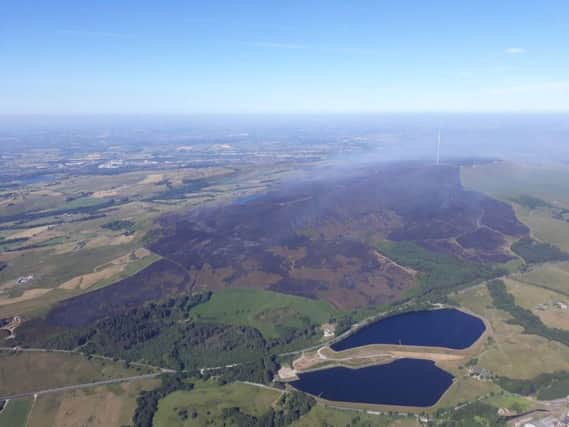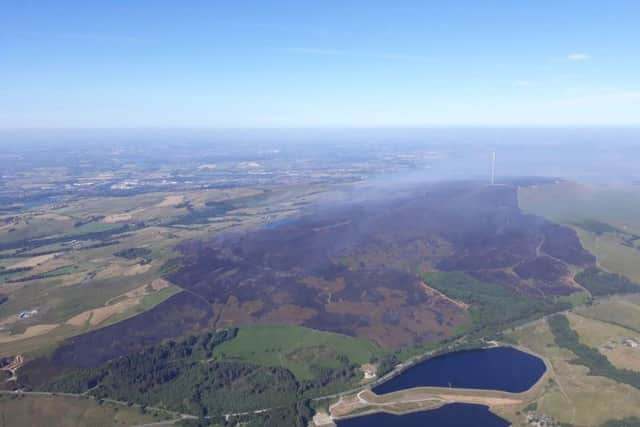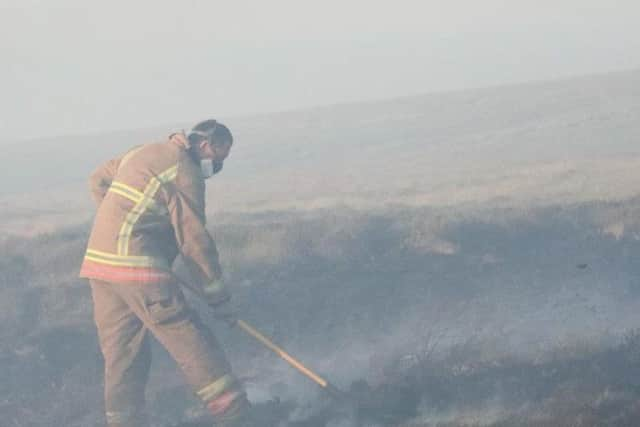Devastating moorland fire at Winter Hill is a 'natural disaster' for Lancashire


Bosses at Lancashire Wildlife Trust have spoken of their complete heartbreak after they inspected scenes around the fire and say the moorland may never be the same after the blaze.
The previously flourishing moorland has, they say, been scorched of all life, leaving a blackened and charred landscape in the wake of one of Lancashire’s worst moorland fires, which is still raging over Winter Hill.
Advertisement
Hide AdAdvertisement
Hide AdAlan Wright, speaking on behalf of the trust, said: “This fire has felt very personal, I live in the area and frequently walk up on the moors and it has been absolutely heart-breaking to see.


“Lots of people walk around Winter Hill and all that is left there now is a blackened and burnt landscape.
“This is a natural disaster for the people of Lancashire.
“We can be certain that a lot of wildlife has been killed by the fire.
“It has meant the loss of thousands of birds, amphibians and small mammals from the area.
Advertisement
Hide AdAdvertisement
Hide Ad

“Curlews, Lapwings and Meadow Pipits are among the birds we believe have been killed in the fire as well as rabbits, voles and possibly deer and foxes.
“We’ve even heard that sheep are dying around the fire.
“A lot of the animals’ food sources such as Cotton Grass and some smaller insects have also been destroyed.
“This means we will have fewer butterflies and fewer bees.
“It’s obviously very difficult to completely quantify exactly how much has been lost.
“But what we do know is that it will take years for the moor to recover and some species may never return.”
Advertisement
Hide AdAdvertisement
Hide AdBosses at the trust now say that a new approach to managing the moorland is now necessary to stop future fires.
Tim Mitcham, Director of Conservation at the Wildlife Trust, said: “It has been burnt into a mess of a landscape.
“I was there a couple of nights ago and it was a horrible sight to behold.
“It’s very early to say how long it will take to recover, but one thing for sure is it will never be the same again.
Advertisement
Hide AdAdvertisement
Hide Ad“With the warming of the climate, unless we change the way we manage the landscape we could experience more of these types of fire.
“Farmers, the community and people who use the area for leisure activities need to work together to come up with a new way forward.”
Fighting fire with fire... literally
Firefighters tackling the devastating moorland blaze at Winter Hill are deploying an unexpected tool to fight the devastation...fire itself.
Tony Crook, command support officer for Lancashire Fire and Rescue Service, which has coordinated around 150 firefighters a day to tackle the unprecedented disaster, says they are now literally fighting fire with fire as they try to put and end to the devastation.
Advertisement
Hide AdAdvertisement
Hide AdTeams of specialist firefighters have been setting fires ahead of the blaze in an effort to create a so-called ‘burn front’, which helps cut off the fuel source to the main fire and helps contain the flames.
Since it broke out last month, hundreds of firefighters have been called in from around the country to tackle the biggest disaster the county has seen in decades.
Yesterday 20 fire engines were called back to the fire, which has so far devastated an eight square kilometre area leaving blackened, scorched earth in its wake. Even drones and police helicopters have been dispatched in the hunt for information about how the fire is spreading.
Mr Crook, whose team has been working around the clock in sweltering conditions, said: “Specialist burn teams from South Wales have been deployed to create burn fronts where they burn off areas to create a front - we are literally fighting fire with fire.
Advertisement
Hide AdAdvertisement
Hide Ad“Helicopters provided by United Utilities have been dropping thousands of litres of water onto flare ups. They have been doing an amazing job.
“All our firefighters have done a brilliant job. Some staff do not want to leave the fire ground because they just want to get the job finished.
“We have seen so much sheer hard work from our crews. I have seen firefighters working in intense heat standing on the moorland using beaters to beat the flames back for hours and hours at a time.
“Staff have been stood on top of the hill enshrouded in smoke and working wearing respirators in all that smoke.”
Advertisement
Hide AdAdvertisement
Hide AdFirefighters have today issued a map showing people areas they need to stay away from in a bid to stop preventable fires in the area.
A spokesman for LFRS said: “With more fine weather to come over the next few days and into the weekend, Bolton Mountain rescue team have helped us to create a map which shows the areas we need people to stay clear of.
“This is not only for public safety but to help us maintain the progress we’ve made so we can give you back full access.”